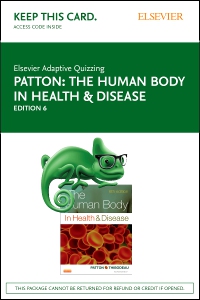
Elsevier Adaptive Quizzing for The Human Body in Health and Disease (Access Card), 6th Edition
Elsevier Adaptive Quizzing - Access Card

Corresponding chapter-by-chapter to The Human Body in Health & Disease - Softcover, 6th Edition, Elsevier Adaptive Quizzing integrates seamlessly into your course to help students of all skill levels focus their study time and effectively prepare for class, course exams, and summative exams. Elsevier Adaptive Quizzing is comprised of a bank of high-quality practice questions that allows students to advance at their own pace — based on their performance — through multiple mastery levels for each chapter. A comprehensive dashboard allows students to view their progress and stay motivated. The educator dashboard, grade book, and reporting capabilities enable faculty to monitor the activity of individual students, assess overall class performance, and identify areas of strength and weakness, ultimately helping to achieve improved learning outcomes.
-
- UNIQUE! Elsevier’s trusted, market-leading content serves as the foundation for all questions, which are written, reviewed, and leveled by experienced summative exams educators, item writers, and authors. Each question will be accompanied by a specific chapter and page within your Elsevier text for convenient reference.
- UNIQUE! Unfolding questions become progressively more complex as students advance to higher levels, incorporating concepts such as delegation, multi-system diseases, or complicating conditions to help students strengthen their critical thinking and clinical reasoning skills.
- UNIQUE! Essential test-taking tips and strategies help students learn how to successfully dissect and tackle different question types and improve test-taking skills for both course exams and the summative exams.
- Confidence level indicators allow students to indicate their confidence when submitting answers, providing UNIQUE! Students can practice in Study Mode, which provides immediate feedback, or in Exam Mode where the quiz is timed and results are summarized at the end.
- UNIQUE! In addition to detailed rationales for each question, select questions include interactive, multimedia resources such as illustrations, animations, videos, audio clips, summary tables, and study tips to engage students with different learning styles and reinforce challenging material.
- The engaging, easy-to-use interface ensures that students and educators can navigate through the program with ease.
- Multiple mastery levels for each chapter allow students to progress from one level to the next based on individual performance.
- Alternate item format questions — including multiple-response, fill-in-the-blank, prioritizing, graphic options, chart/exhibit, video, audio, and hot spot — provide valuable summative exams exam preparation.
- The comprehensive student dashboard allows each individual to view their personal learning progress with summaries of their strengths, weaknesses, mastery levels, and normative data.
- A robust educator dashboard and grade book highlight class scores and levels; usage and performance summaries; areas of strength and weakness tied to chapters for each student and class; and normative data that educators can use to modify lectures or class activities accordingly.
-
1. An Introduction to the Structure and Function of the Body
2. Chemistry of Life
3. Cells
4. Tissues
5. Organ Systems of the Body
6. Mechanisms of Disease
7. The Integumentary System and Body Membranes
8. The Skeletal System
9. The Muscular System
10. The Nervous System
11. The Senses
12. The Endocrine System
13. Blood
14. The Heart
15. The Circulation of the Blood
16. The Lymphatic System and Immunity
17. The Respiratory System
18. The Digestive System
19. Nutrition and Metabolism
20. The Urinary System
21. Fluid and Electrolyte Balance
22. Acid-Base Balance
23. The Reproductive Systems
24. Growth and Development
25. Genetics and Genetic Diseases
Appendix A: Examples of Pathological Conditions
Appendix B: Medical Terminology
Appendix C: Clinical and Laboratory Values
Glossary
Illustration/Photo Credits
Index

 as described in our
as described in our 